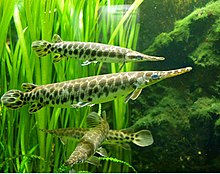Gar(Gar Family)
This article is about North American freshwater fish of the family Lepisosteidae. For other uses, see Gar (disambiguation).
| Gar Temporal range: Late Cretaceous–Recent [1] | |
|---|---|
 | |
| Lepisosteus oculatus | |
| Scientific classification | |
| Kingdom: | Animalia |
| Phylum: | Chordata |
| Class: | Actinopterygii |
| Order: | Lepisosteiformes O. P. Hay, 1929 |
| Family: | Lepisosteidae Cuvier, 1825 |
| Genera | |
| Atractosteus Lepisosteus | |
[edit] Etymology
In British English the name gar was originally used for a species of needlefish, Belone belone, found in the North Atlantic, itself likely named after the Old English word gar meaning "spear".[4] Belone belone is now more commonly referred to as the "garfish" or "gar fish" to avoid confusion with the North American gars of the family Lepisosteidae.[5] Confusingly, the name "garfish" is commonly used for a number of other species of the related genera Strongylura, Tylosurus and Xenentodon of the family Belonidae as well as of some more distantly related genera in the suborder Belonoidei.[6]The genus name Lepisosteus comes from the Greek lepis meaning "scale" and osteon meaning "bone".[7] Atractosteus is similarly derived from Greek, in this case from atraktos, meaning "arrow".[8]
Distribution
The gars are members of the Lepisosteiformes (or Semionotiformes), an ancient order of "primitive" ray-finned fish; fossils from this order are known from the late Cretaceous onwards. Fossil gars are found in Europe, South America, and North America, indicating that in times past these fish had a wider distribution than they do today. Gars are considered to be a remnant of a group of rather primitive bony fish that flourished in the Mesozoic, and are most closely related to the bowfin, another archaic fish now found only in North America. There are many species of gar, including the alligator gar that can exceed 10 feet in length.Anatomy and morphology
All the gars are relatively large fish, but the alligator gar Atractosteus spatula is the largest, as specimens having been recorded up to 3 metres (9.8 ft) in length.[10]Even the smaller species, such as Lepisosteus oculatus, are large, commonly reaching lengths of over 60 centimetres (2.0 ft), and sometimes much more.[11]
Ecology
Gars tend to be slow moving fish except when striking at their prey. They prefer the shallow and weedy areas of rivers, lakes, and bayous often congregating in small groups.[2] They are voracious predators, catching their prey with their needle-like teeth, obtaining with a sideways strike of the head.[11] Gars feed extensively on smaller fish and invertebrates such as crabs.[10] Gars are found across all of North America (for example Lepisosteus osseus).[2] Although gars are primarily found in freshwater habitats several species enter brackish waters and a few, most notably Atractosteus tristoechus, are sometimes found in the sea. Some gars travel from lakes and rivers through sewers to get to ponds.[2][12]Species
The gar family contains seven species, in two genera:[1]Family Lepisoteidae
- Genus Atractosteus Rafinesque, 1820
- Atractosteus spatula (Lacépède, 1803) (Alligator gar)
- Atractosteus tristoechus (Bloch & J. G. Schneider, 1801) (Cuban gar)
- Atractosteus tropicus Gill, 1863 (Tropical gar)
- Genus Lepisosteus Linnaeus, 1758
- Lepisosteus oculatus Winchell, 1864 (Spotted gar)
- Lepisosteus osseus (Linnaeus, 1758) (Longnose gar)
- Lepisosteus platostomus Rafinesque, 1820 (Shortnose gar)
- Lepisosteus platyrhincus DeKay, 1842 (Florida gar)





No comments:
Post a Comment